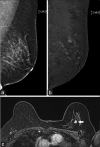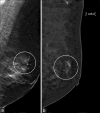Contrast-enhanced spectral mammography
- PMID: 38527307
- PMCID: PMC11060636
- DOI: 10.4103/singaporemedj.SMJ-2021-268
Contrast-enhanced spectral mammography
Conflict of interest statement
There are no conflicts of interest.
Figures









References
-
- Francescone MA, Jochelson MS, Dershaw DD, Sung JS, Hughes MC, Zheng J, et al. Low energy mammogram obtained in contrast-enhanced digital mammography (CEDM) is comparable to routine full-field digital mammography (FFDM) Eur J Radiol. 2014;83:1350–5. - PubMed
-
- Fallenberg EM, Schmitzberger FF, Amer H, Ingold-Heppner B, Balleyguier C, Diekmann F, et al. Contrast-enhanced spectral mammography vs. mammography and MRI – clinical performance in a multi-reader evaluation. Eur Radiol. 2017;27:2752–64. - PubMed
-
- Sumkin JH, Berg WA, Carter GJ, Bandos AI, Chough DM, Ganott MA, et al. Diagnostic performance of MRI, molecular breast imaging, and contrast-enhanced mammography in women with newly diagnosed breast cancer. Radiology. 2019;293:531–40. - PubMed
-
- Hobbs MM, Taylor DB, Buzynski S, Peake RE. Contrast-enhanced spectral mammography (CESM) and contrast enhanced MRI (CEMRI): Patient preferences and tolerance. J Med Imaging Radiat Oncol. 2015;59:300–5. - PubMed
MeSH terms
Substances
LinkOut - more resources
Full Text Sources
Medical

